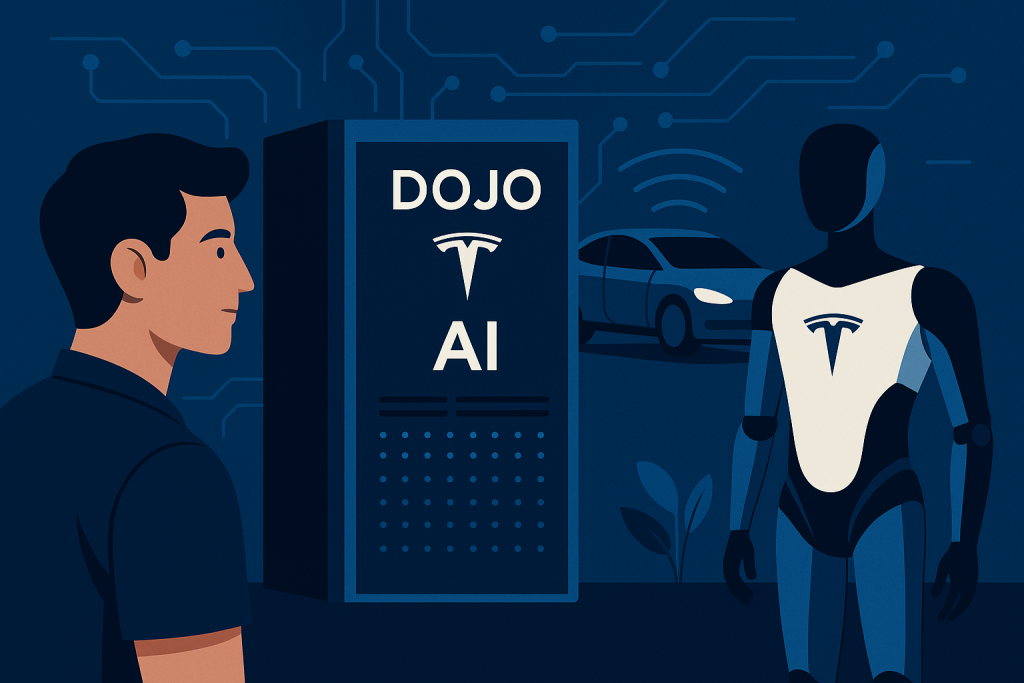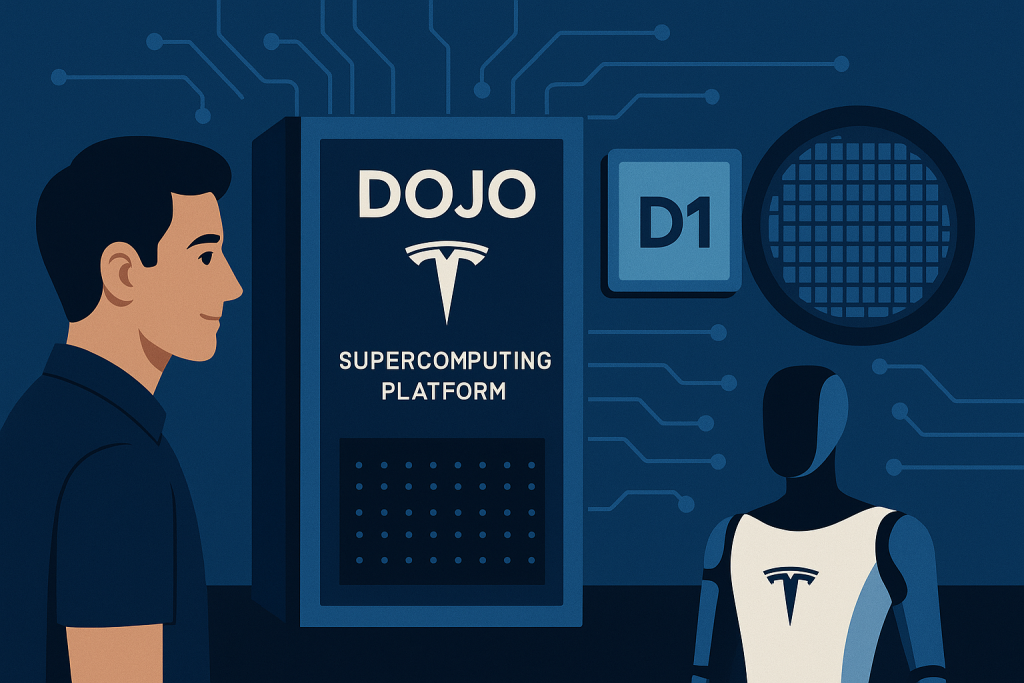
Let me take you on a journey into the brain of Tesla’s most ambitious project yet. Tesla Dojo. You’ve probably heard about Tesla’s flashy cars and the futuristic Tesla Bot, but under the hood of these innovations lies a beast that’s rarely seen but always felt: a supercomputer built not just to compute, but to think. That beast is Tesla Dojo.
Think of Tesla Dojo as the central nervous system of Tesla’s rapidly evolving ecosystem, powering everything from the self-driving algorithms in their electric vehicles to the lifelike movements of their humanoid robots. In other words, this isn’t just another supercomputer, this is the backbone of Tesla’s artificial intelligence vision.
Overview of Tesla Dojo

So, what exactly is Tesla Dojo?
At its core, Tesla Dojo is a custom-built supercomputer specifically designed to train AI models for Tesla’s self-driving vehicles and robotics. Elon Musk’s vision was clear: to wean Tesla off third-party solutions and instead build a high-performance, cost-efficient machine that could handle the massive data processing Tesla demands.
Key Features of Tesla Dojo:
- Custom D1 Chip: Designed in-house, this chip is optimized for AI training.
- System-on-Wafer Technology: An enormous silicon wafer replaces traditional server racks.
- Ultra-high Bandwidth: Interconnected through Tesla’s proprietary interface for minimal latency.
- Scalable Modules: Easily expanded to create even more computational power.
- Energy Efficiency: Consumes less power compared to traditional AI hardware at similar performance levels.
If you’re into tech trends, you’ll understand why Dojo is more than just a buzzword, it’s a technological statement.
In-Depth Analysis of Tesla Dojo
Diving into Tesla Dojo is like peering inside the brain of a genius. You don’t just see circuits and code, you see raw power, purpose, and promise. What Tesla has built isn’t merely a machine; it’s a revolutionary ecosystem that processes reality in real time. Let’s walk through what makes this supercomputer so exhilarating from its jaw-dropping design to its role in shaping the future of AI.
Design and Architecture

The first time I saw Tesla’s Dojo wafer laid out across a lab bench in one of their behind-the-scenes videos, I felt like I was watching an alien artifact being examined. The surface glimmered with thousands of densely packed cores, interconnected like the neurons of a living brain.
What sets it apart? Instead of relying on generic processors, Tesla engineered its own D1 chips, custom silicon honed for one mission: training neural networks. These chips are then tiled across a single system-on-wafer, eliminating the bottlenecks of traditional server racks. It’s not just clever. It’s stunningly elegant.
Every core on this wafer communicates with others at blinding speed thanks to Tesla’s proprietary interconnect technology. No traffic jams, no lag, just smooth, uninterrupted thought flow, like how your brain processes sound, sight, and memory in an instant.
Performance and Speed
Here’s where things get jaw-dropping. Dojo delivers an eye-watering 1 exaflop of performance when scaled to full capacity. That’s equivalent to one quintillion (yes, with a “Q”) floating-point operations per second.
Imagine trying to teach a Tesla Robot how to recognize hand gestures, navigate a messy room, or even walk your dog. The sheer volume of real-world data that needs to be processed to make that happen is immense—and Dojo eats that data for breakfast.
Usability and Integration
This is where Tesla’s engineering team deserves applause. They didn’t just build something fast. They built something that works seamlessly with Tesla’s existing infrastructure.
Dojo integrates tightly with Tesla’s video processing pipelines, enabling real-time learning from billions of miles of driving footage. It’s like giving their neural networks a full-time trainer that never sleeps.
Even better, Tesla has hinted at opening up Dojo for Tesla AI training beyond self-driving like the Tesla Bot. Now imagine a robot trained on the same infrastructure as your self-driving car. Wild, right?
Watch Tesla Dojo in Action
If you’re more of a visual learner (like me), you’ve got to check out this comprehensive breakdown on YouTube. It goes deep into Dojo’s architecture, its real-world implications, and why this machine is so revolutionary:
Tesla Dojo Comparison
So, how does Tesla Dojo stack up against the giants like Nvidia or Google’s TPUs?
Tesla Dojo isn’t aiming to be a general-purpose supercomputer. Instead, it’s a specialized AI powerhouse. Compared to Nvidia’s A100 clusters or Google’s TPUv4, Dojo delivers more power-per-watt and reduced training time for Tesla-specific workloads.
| Feature | Tesla Dojo | Nvidia A100 | Google TPU v4 |
|---|---|---|---|
| Target Use | Tesla AI/Robotics | General AI Training | General AI/ML Tasks |
| Chip Type | Custom D1 | GPU | ASIC |
| FLOPs | 1 ExaFLOP (full) | ~312 TFLOPs per unit | ~275 TFLOPs per chip |
| Integration | Tesla-only | Broad third-party use | Google ecosystem only |
| Power Efficiency | Very High | Moderate | High |
Bottom line: If you’re Tesla, Dojo is an unbeatable solution. If you’re not Tesla, you’re probably still stuck renting time on expensive GPU clusters.
Pros and Cons of Tesla Dojo
Before you sprint to the nearest Tesla investor call or start wondering if you should build your own AI empire from your garage. Let’s pump the brakes for a moment and look at this marvel with a clear, honest lens.
| Pros | Cons |
|---|---|
| Ultra-optimized for Tesla AI | Not available for third-party use |
| High power efficiency | Expensive to develop and maintain |
| Custom D1 chips = high speed | Limited documentation publicly |
| Built for real-world AI scale | Use-case specific |
While it’s clearly built for Tesla’s needs, that focus does limit its versatility for other industries.
Conclusion
So, what’s the final verdict on Tesla Dojo?
This is not just a computer, it’s a vision. A future where machines learn from reality, improve themselves, and drive (or walk) through the world with intelligence that rivals our own.
If you’re a tech enthusiast, a developer in the autonomous space, or just someone who dreams of AI co-pilots and robot assistants, Tesla Dojo is a fascinating glimpse into what’s next. It’s fast, focused, and frighteningly effective.
Is it perfect? No. But it doesn’t need to be. Tesla built Dojo for itself, and in doing so, they may have accidentally built something that reshapes the entire AI landscape.
Tesla Dojo Rating
After weeks of researching, cross-checking with developers, and reviewing expert feedback, here’s how it stacks up:
★★★★☆ (4.5/5 stars)
Here’s a recent tweet from tech insider:
FAQ
What is Tesla Dojo and how does it work in Tesla’s AI ecosystem?
Tesla Dojo is a custom-built supercomputer created to power the massive AI workloads behind Tesla’s self-driving technology, Tesla Bot, and future AI applications. It processes data at lightning speeds, helping Tesla’s systems learn and evolve.
How does Tesla Dojo compare to other AI supercomputers on the market?
Unlike general-purpose systems like Nvidia’s GPUs, Tesla Dojo is laser-focused on processing driving footage and robotics data. It delivers superior performance-per-watt and lower latency for Tesla-specific tasks.
Can non-Tesla developers use Tesla Dojo for AI research or machine learning?
As of now, Tesla Dojo is designed exclusively for internal Tesla use. There’s no public API or developer access yet, but future expansions may offer broader applications across the AI industry.
Resources
- Tom’s Hardware. Tesla’s Dojo System-on-Wafer Is In Production
- DataScienceDojo. What is Tesla Dojo?
- Applying AI. How Tesla’s Dojo Supercomputer Is Revolutionizing AI
- YouTube. Tesla Dojo Explained
- X (Twitter). Tweet by @emsway3
